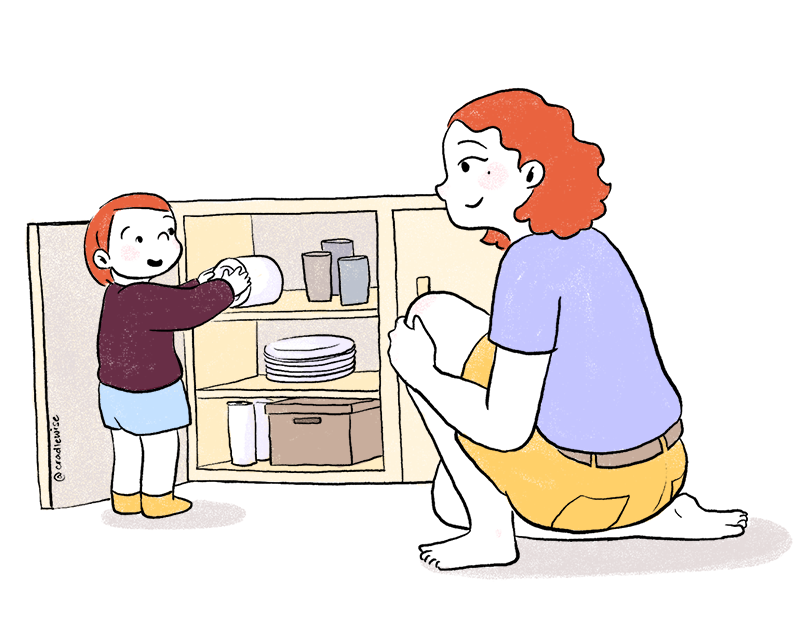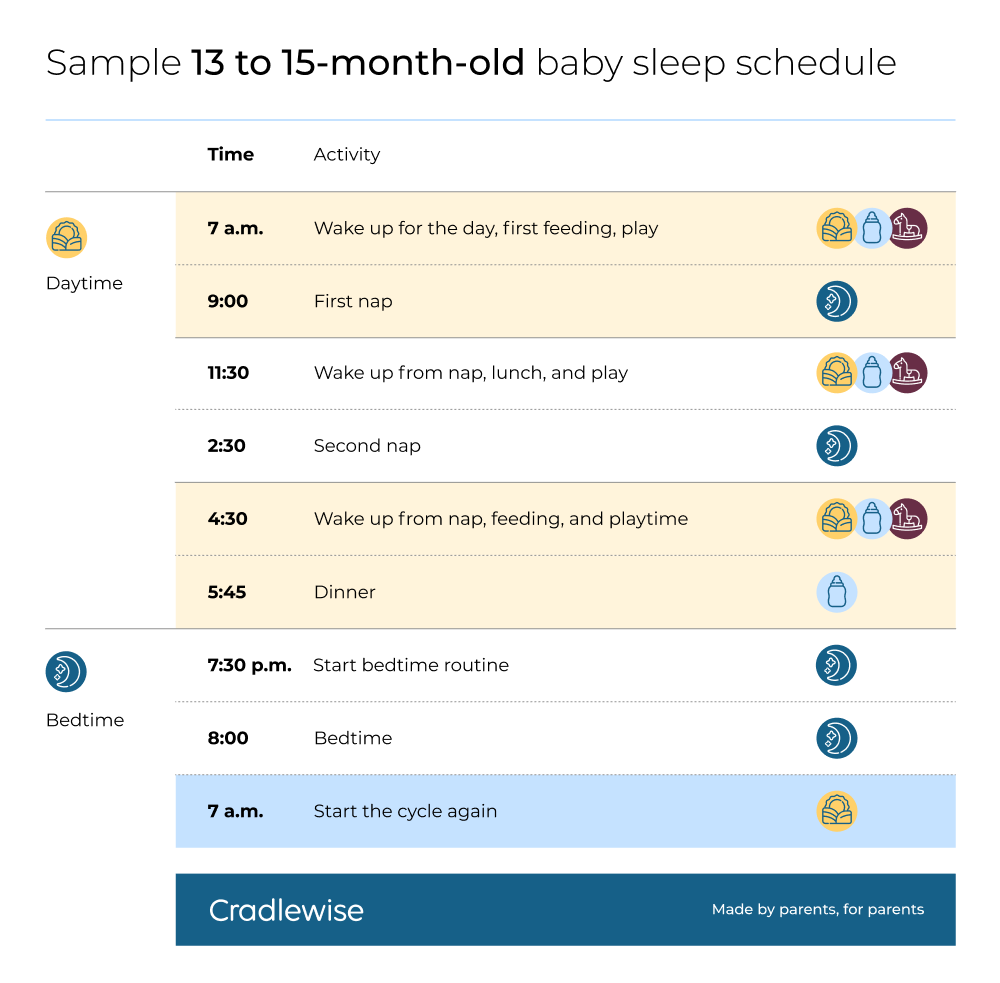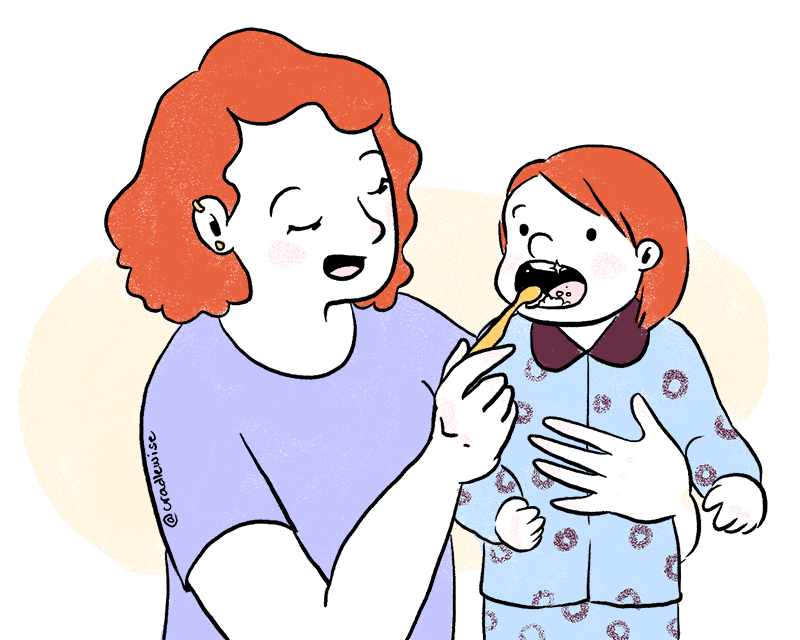
Night sleep
10-12 hours

Daytime naps
1-2 hours

Total sleep
11-14 hours
As your baby moves fully into their toddler phase from 13 to 15 months old, you’ll probably notice a lot of leaps and bounds in their development.
Every child is different, of course, but many toddlers at this age are walking, exploring, trying new foods, and in some cases, experiencing sleep changes as well.
Growth spurts, new developmental milestones, and even changes in their sleep environment — like moving to their own room — can all impact how well your child is sleeping.
As your toddler grows, you may need to adjust certain parts of their sleep routine, like naptime, while preserving others, like their favorite bedtime stories.
Navigating sleep might feel like a constant back-and-forth, but the good news is, any setbacks in your child’s healthy sleep habits are most likely temporary, and a better night’s rest is on the horizon (we promise).
Here’s more about what’s happening with your 13- to 15-month-old in terms of development, sleep milestones, nutrition needs, and more.
13- to 15-month-old baby milestones for sleep
At 13 to 15 months, your baby’s sleep might remain fairly unchanged from the sleep patterns they established at 1 year old.
But it bears repeating (and repeating!) — every baby is different, so you could notice new milestones in your little one’s sleep.
For instance, some parents may have kept their babies in their room in a separate crib during the first year of life, per the American Academy of Pediatrics (AAP) safe sleep recommendations.
The AAP recommends parents room-share for at least the first six months of their baby’s life, up to 12 months. Now that your baby is older, however, it could be time to move them into their own room and experiment with more independent sleeping.
Most toddlers this age will still need at least two naps daily, but some may lean toward dropping that morning nap as early as 13 to 15 months.
This transition can be tough, and you may be in for some cranky, overtired afternoons.
If you’re unsure whether your toddler’s ready to switch from two naps per day to one, our best advice is this: Don’t rush it. When it comes to child sleep, it’s always best to err on the side of making sure they get more, not less.
In general, most babies will transition to only one nap closer to 18 to 24 months.
But if you notice your 13- to 15-month-old toddler is resisting bedtime, resisting their morning nap, or having trouble falling asleep — and staying asleep — during their usual morning naptime, you may decide to extend your toddler’s wake windows (the periods of alert play between daytime naps) gradually to phase out the morning nap.
What’s going on in your baby’s brain?

From 13 to 15 months, your toddler is experiencing a burst of growth and development, especially in their motor skills.
That means that in toddlers without any special needs, you’re going to see a lot of new physical abilities.
According to the Centers for Disease Control and Prevention (CDC), some new physical abilities you might see in your toddler include:
- Walking and running independently
- Exploring new places, like cupboards
- Climbing stairs, steps, and whatever else they can!
- Wanting to go down slides and play more at the park
- Stacking blocks
- Feeding themselves independently with their fingers
Your toddler is going through a lot of cognitive, emotional, and social development these months as well.
For instance, they’ll be talking a lot more, imitating you and other children their age, and showing a lot of new emotions as they start to understand more about the world around them.
How much should a 13- to 15-month-old sleep?
From 13-15 months, your baby’s sleep needs stay about the same as they did at 1 year old.
According to the CDC, your baby should get a total of around 11 to 14 hours of sleep every day, which includes naps.
- Total hours of sleep: 11 to 14 hours
- Wake windows: 3.5 to 4 hours
- Number of naps: 2
Sample 13- to 15-month-old sleep schedule
At this stage, your baby’s sleep schedule could be much the same as it was at 1 year old — or, you could find yourself experimenting with parts of their sleep routine.
For instance, your baby’s wake windows could be lengthening by as much as 30 minutes to an hour as your baby develops, which may require tweaking your baby’s nap schedule.
If your baby is showing early signs of being ready to drop the morning nap (resisting naptime or bedtime, or not sleeping for long during their morning nap), you may need to move up the start time for their afternoon nap, as they transition to one nap per day.
Watch your baby’s cues, and again, err on the side of more sleep.
If you’ve already set a solid sleep schedule at one year of age and it’s working, keep that schedule going! There’s no need to change anything just yet.


13- to 15-month-old feeding tips
As your baby moves into toddlerhood, they’ll start to get the bulk of their calories and nutrition from solid foods, just like adults.
However, if you’re nursing, you can continue to nurse or provide your child with breast milk for as long as you would like.
The World Health Organization recommends nursing for as long as mutually desired by both parent and child until the age of two.
Choosing the best foods for 13- to 15-month-old toddlers can be surprisingly straightforward: You can offer your child any food that your family is eating, in appropriately-sized and prepared portions.
For instance, you’ll want to avoid choking hazards, like hot dogs, whole grapes, and popcorn, and be sure to cut all meat and raw vegetables.
But in general, your 13- to 15-month-old will need the same food groups as an adult, with a heavier emphasis on fat, which should make up about half of their calories.
- How much should a 13- to 15-month-old eat? According to the AAP, 1-year-olds need about 1,000 calories per day, with half of those calories coming from fat.
This calorie count may be slightly higher for a 15-month-old — with toddlers, even a few months can make a difference! - How much should a 13- to 15-month-old weigh? By 15 months, the average female toddler is about 23 pounds and 30.5 inches tall, while the average male toddler is 24.5 pounds and 31 inches tall, according to the AAP.
- How often should a 13- to 15-month-old eat? Your early toddler should eat 3 meals and be offered 2 snacks a day, says the AAP.
However, it’s normal for toddlers to have less-than-predictable hunger cycles — meaning they may eat more at some meals and less at others, depending on the day.
You can encourage your toddler to listen to their own bodies and eat when they are hungry and stop when they are full. - Tip: Avoid choking by making sure your toddler is always supervised while eating and never give them peanuts, whole grapes, cherry tomatoes, carrots, seeds, meat sticks, hard candies, or large chunks of peanut butter.
- Tip: Growing toddlers need plenty of hydration — stick to water and milk and leave juice off the table whenever possible.
How to help support your baby’s sleep from 13-15 months

Keep the following helpful sleep tips in mind:
Keep two naps a day as long as possible.
Keep two naps a day as long as possible.
While it’s important to follow your baby’s cues for sleep, it’s also important to remember that for toddlers especially, being energetic and hyper can be a sign of being overtired. So even if your baby sometimes resists sleep at night or at naptime, that doesn’t necessarily mean they’re ready to drop to one nap per day. If you’re sticking with your baby’s regular sleep routine and they’re consistently not sleeping at their first or second nap or at bedtime, then it may be time to re-evaluate. But don’t rush to drop that morning nap after just one day of sleep resistance.
Offer plenty of fresh air.
Offer plenty of fresh air.
Your 13- to 15-month-old is going through a stage that’s all about learning, exploring, and testing boundaries. You can support their skills by making sure your little one gets plenty of play time, especially outdoors. Not only will outdoor play help your toddler get fresh air and fresh ways to explore, it also helps prepare their bodies and minds for sleep. Some toddler-safe outdoor activities include using a balance bike, offering sidewalk chalk in a holder, playing on a toddler playscape, or just taking a (very slow) walk.
Give your toddler time to adjust to new routines.
Give your toddler time to adjust to new routines.
If you’re introducing new changes to your toddler’s sleep routine in these months, like moving them to a new room, it’s very normal to encounter some resistance in their sleep, even if they’ve been a great sleeper before. Think of it as “restarting” your sleep routine, and give them time to adjust before throwing in the towel. Stay consistent and give them at least two weeks to adjust.
Drop bedtime snacks or feeds.
Drop bedtime snacks or feeds.
The Pediatric Sleep Council recommends that somewhere around 15 months old, parents consider dropping nighttime snacks and feeds. That means to be sure your toddler is fed well before you start the bedtime routine, so they don’t associate nighttime with snack time. (That might be a helpful rule for the grownups in the house too, come to think of it…) Making this switch can especially be helpful if you have a child who prefers to feed to sleep. Now that your toddler has most of their baby teeth, phasing out food, milk, or other feeds at bedtime lets you ensure their teeth are clean before bed, too.
More posts you might like:
- 16- to 18-month-old baby sleep guide
- 19- to 21-month-old toddler sleep guide
- 22- to 24-month-old toddler sleep guide
Sources:
- Safe sleep recommendations. 2022. Pediatrics. Sleep-Related Infant Deaths: Updated 2022 Recommendations for Reducing Infant Deaths in the Sleep Environment.
- The one-nap transition. 2023. Cradelwise. How do you know when a baby is ready to drop to one nap? 6 tell-tale signs.
- 15-month-old milestones. Centers for Disease Control and Prevention. Important Milestones: Your Baby By Fifteen Months.
- Sleep recommendations for infants and toddlers. 2023. Centers for Disease Control and Prevention. How Much Sleep Do I Need?
- Breastmilk recommendations. 2023. Centers for Disease Control and Prevention. Key Breastfeeding Indicators.
- Average height and weights for toddlers. 2009. HealthyChildren.org. Physical Appearance and Growth: Your 1-Year-Old.
- Feeding your one-year-old. 2022. Centers for Disease Control and Prevention. Feeding & Nutrition Tips: Your 1-Year-Old.
- Toddler nutrition. 2021. American Academy of Pediatrics. Toddler Food and Feeding.
- Toddler hydration. 2020. American Academy of Pediatrics. Choose Water for Healthy Hydration.
- 15-month-old baby sleep. n.d. Pediatric Sleep Council. Month 15.
You may also like




